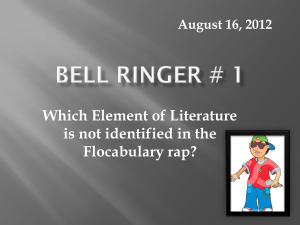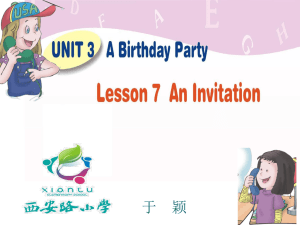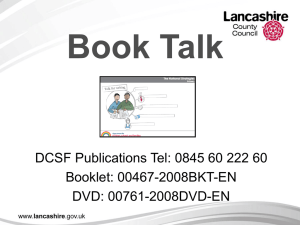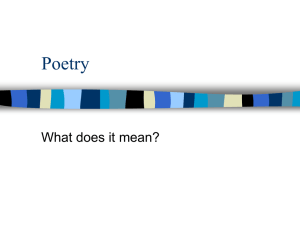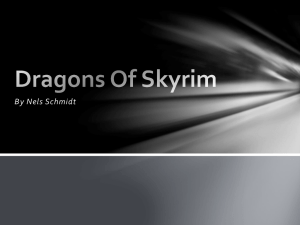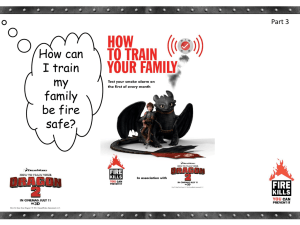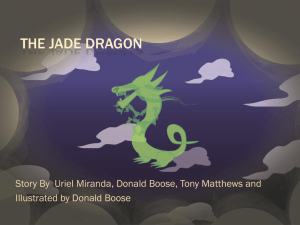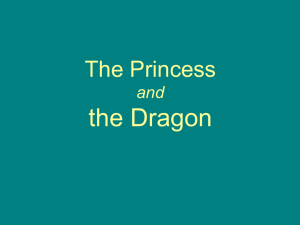Dragon Dragon PPT
advertisement
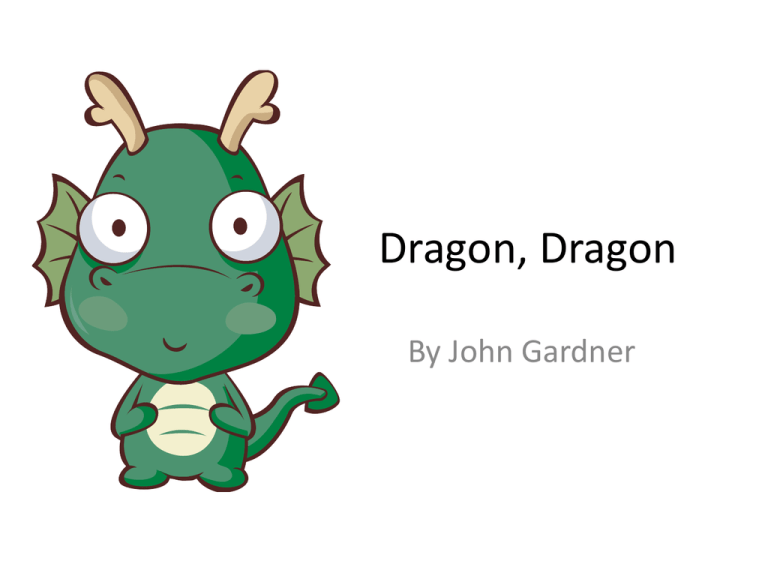
Dragon, Dragon By John Gardner Setting Up the Vocabulary Section in Your Reading Journal Selection Vocabulary + — Neutral plague (plāg) plague (plāg) Part of speech: Verb Definition: continually causing trouble and suffering Example: Even though we kept the food in closed containers, ants plagued our picnic. Ask: Who/What plagues you in your life? Related words: • plague (noun) - a very contagious disease which usually causes death (e.g., the Black Plague) • plague (noun) – a large number of unpleasant things that happen at the same time rav·age (rav′ ij) rav·age (rav′ ij) Part of speech: Verb Definition: destroy Example: Rabbits ravaged Jon’s vegetable garden, so he built a fence around it. Ask: What types of natural disasters can ravage a town? ty·rant (tī′ rənt) ty·rant (tī′ rənt) Part of speech: Noun Definition: someone who uses power or authority in a cruel and unjust manner. Example: Our school’s soccer coach is strict, but she isn’t a tyrant. Ask: Who are some characters in books/movies that you would consider to be tyrants? Related words: • tyranny (noun) - a cruel, harsh, unjust government • tyranny (noun) – cruel, unfair treatment • tyrannical (adjective) – being cruel and unfair toward those who are under your power quest (kwest) quest (kwest) Part of speech: Noun Definition: a search or pursuit made in order to get an object or accomplish a goal Example: The boy was on a quest to find his misplaced homework. Ask: What movies have you seen in which a character was on a quest? Related words: • question (noun) – When asking a question, you are in search of an answer. meek (mēk) meek (mēk) Part of speech: Adjective Definition: 1. lacking self-assurance; not courageous 2. mild/gentle in speech and action 3. patient; not responding to wrongs Example: Bob is bold and firm when he speaks with others; however, Billy is meek. Ask: When would it be good to behave meekly? When would it not be good? Related words: • meekly (adverb) – acting in the ways described above Does your Vocabulary Notebook page look something like this? What kinds of predictions can you make about the story “Dragon, Dragon” based on these words? plagued ravaged tyrant quest meekly Fiction Realistic Fiction Folktales Historical Fiction Fables Science Fiction Myths Fantasy Legends Adventure Fairy Tales Mystery What are some common characteristics of fairy tales? Pass the Paper! Reading Footnotes p. 86 Now it happened that there lived in the kingdom a wise old cobbler² who had a wife and three sons. The cobbler and his family came to the king’s meeting and stood way in back by the door, for the cobbler had a feeling that since he was nobody important there had probably been some …. _______________________________________________________________________________ ² A cobbler is a person who makes or mends shoes. As you read “Dragon, Dragon”… • stop occasionally to check your understanding of the story by retelling the main events so far. • take notice of the elements of a fairy tale that the author incorporates. Happy Reading! Italics • p. 93 “What?” cried the dragon, flabbergasted. “You? You? Murder Me???” All at once he began to laugh, pointing at the little cobbler’s son. “He he he ho ha!” laughed the dragon....” The cobbler’s son was annoyed. “I do come from the king to murder you,” he said. Italics p. 93 “Of course not, poor dear boy! But really, he he, the idea of it, ha ha ha! And that simply ridiculous poem!” Tears streamed from the dragon’s eyes and he lay on his back perfectly helpless with laughter. •Why did the author use italics in the previous paragraphs? •What is the reader supposed to understand? Summarize! Check Yourself! A smart move that we, as good readers, can make is to stop at the end of a story and try to retell the whole story (to ourselves or with a partner) to be sure that we understand the story and remember it correctly. It’s really hard to answer questions about a story that you can’t remember or don’t understand. If you’ve finished reading an entire story, you should be able to retell the main ideas by using the “Somebody Wanted But So Then Finally” framework. Give it a try! (Use the next slide to guide your thinking as you retell “Dragon, Dragon” with a partner.) Fiction Summary Then So But Wanted Somebody Finally Sequence & Cause/Effect Teacher: See information in “Notes” section of this slide for resource/practice information regarding sequence and cause/effect. Stylistic Elements in Fairy Tales What are some common characteristics of fairy tales in “Dragon, Dragon”? Stylistic Element: Threes •What stories/fairytales can you think of that have three of something (e.g., “Goldilocks and the Three Bears”)? •Why do you think so many stories are based upon the use/structure of threes? It takes three things to establish a pattern. Three characters provide a nice balance (big, medium, small; oldest, middle, youngest). Three events/wishes/attempts to solve a problem are just enough to build suspense and round out the action. Stylistic Element: Threes •People remember things in threes better. Documents/Speeches: “…life, liberty, and the pursuit of happiness.” Advertisements: “Location, location, location!” Procedures: “Stop, drop, and roll.” Sayings: “Live, love, and laugh;” “Blood, sweat, and tears” Organizations: Executive, Judicial, Legislative branches of government How did the author of “Dragon, Dragon” use the stylistic element of threes to develop the story? 3. 2. 1. Purpose of Repetition p. 89 “When and if you come to the dragon’s lair, recite the following poem. Dragon, dragon, how do you do? I’ve come from the king to murder you. Say it very loudly and firmly, and the dragon will fall, God willing, at your feet.” “How curious!” said the eldest son. And he thought to himself, “The old man is not as wise as I thought.” Purpose of Repetition p. 91 “When and if you come to the dragon’s lair, recite the following poem. Dragon, dragon, how do you do? I’ve come from the king to murder you. Say it very loudly and firmly, and the dragon will fall, God willing, at your feet.” “What an odd thing to say!” thought the middle son. “The old man is not as wise as I thought.” Purpose of Repetition p. 93 “When and if you come to the dragon’s lair, recite the following poem. Dragon, dragon, how do you do? I’ve come from the king to murder you. Say it very loudly and firmly, and the dragon will fall, God willing, at your feet.” “Are you certain?” asked the youngest son uneasily. “As certain as one can ever be in these matters,” said the wise old cobbler. And so the youngest son set forth on his quest. Purpose of Repetition p. 93 As loudly and firmly as he could manage, the youngest son cried – Dragon, dragon, how do you do? I’ve come from the king to murder you. “What?” cried the dragon, flabbergasted. “You? You? Murder Me???” And all at once he began to laugh . . . . and then he lay dead. Purpose of Repetition p. 93 The two older brothers crawled out and thanked their younger brother for saving their lives. “We have learned our lesson,” they said. THINK/PAIR/SHARE: What lesson about life did the brothers learn? How does the use of the repeated lines/events in the story develop that theme (message about life)? Purpose of Repetition p. 93 The two older brothers crawled out and thanked their younger brother for saving their lives. “We have learned our lesson,” they said. THINK/PAIR/SHARE: What lesson about life did the brothers learn? How does the use of the repeated lines/events in the story develop that theme (message about life)? Inference Inference Let’s apply the inference skills that we practiced with comic strips to our fairy tales. In “Dragon, Dragon,” the author never directly states that the cobbler is a practical man. However, we can make that inference based on how the cobbler acted and what the cobbler said. “Dragon, Dragon” Inference The four statements below all sound like inferences. However, only one of them can be supported with clues from the text. • Talk with a partner and see if you agree. • Show your partner clues from the text that support your thinking. • Explain why you believe that the incorrect answers can’t be supported. A The cobbler probably liked his youngest son the best. B The reader can tell that the cobbler was a practical man. C The wizard most likely never made any more mistakes after his wizard’s book was returned. D The reader can conclude that the oldest and middle brothers were envious of the younger brother’s success. “Dragon, Dragon” Inference A The cobbler probably liked his youngest son the best. • This might be how I think the cobbler should feel since the youngest son is the only one who listened to his father, BUT… There are NO CLUES in the text that support the idea that the father liked his youngest son the best. C The wizard most likely never made any more mistakes after his wizard’s book was returned. • We don’t know that for sure, based on clues in the story. The fact that the wizard was old and forgetful is actually good reason to believe that he might make a mistake again, despite the return of this book. D The reader can conclude that the oldest and middle brothers were envious of the younger brother’s success. • We as readers may think that would be a natural reaction of the brothers. WE may have felt that way if we were in the oldest and middle brothers’ places. HOWEVER, that is just our opinion. There are NO CLUES in the text to support this statement. “Dragon, Dragon” Inference B The reader can tell that the cobbler was a practical man. Even though the word “practical” was never used in the story to describe the cobbler, we can make that inference by examining how the author acted and what he said. For example: p. 86 “…the cobbler had a feeling that since he was nobody important there had probably been some mistake, and no doubt the king had intended the meeting for everyone in the kingdom except for his family and him.” p. 87 “’…It’s all very well to talk about it – but how are you going to do it?’” p. 87 “Meanwhile the cobbler stood with his hands in his pockets, sighing at the waste of time. ‘About the dragon . . .’ he began.” p. 88 “’It’s not enough,’ said the cobbler. ‘…How would an ordinary person support [the princess]? Also, what about those of us that are already married?’” p. 88 “’It’s a good enough kingdom…, but it’s too much responsibility.’” p. 92 (After his youngest son asks him if he’s certain that saying the poem will help kill the dragon) “’As certain as one can ever be in these matters,’ said the wise old cobbler.” Importance to a Story THINK/PAIR/SHARE: Have you ever… Have you ever made a quick trip to the kitchen for a snack or had some other interruption while watching a TV show or movie, only to return to the show to realize that you had missed something really important? Without the knowledge of that particular missed scene or piece of dialogue, the rest of the show/movie didn’t make sense. THINK/PAIR/SHARE: Have you ever… Or perhaps you don’t realize until you get to the end of the movie that something that happened earlier (a scene, a line of dialogue, a clue in the setting) was actually an important clue that the writer/director included to help you begin to figure out the storyline. THINK/PAIR/SHARE: Have you ever… Or maybe you find yourself yelling at the TV, “Don’t go to the woods!” because you know that if the character does go there, something bad will happen. You know that that particular setting will be a source of problems for the character. Important to the Story An author’s (or movie director’s) decisions to include certain events, descriptions, or dialogue is always purposeful. Sometimes a specific part of a story is important for reasons such as: • it helps the reader understand something about the character (e.g., the character’s emotions, traits, or changes) • it helps the reader understand something about the main problem/goal in the story – or perhaps it helps create or provide circumstances for the problem to occur • it helps the reader understand how the characters are trying to solve the problem/reach the goal and reach a resolution Important to the Story THINK/PAIR/SHARE: • Refer to your plot chart and/or your literature book to help you remember the important events in “Dragon, Dragon.” What do you think is an important setting, event, or line/lines of dialogue in the story? Write it on an index card, and write the reason why it is important on the back of the card. (Each person should have their own index card.) Important to the Story THINK/PAIR/SHARE: • When your teacher gives the signal, walk around the room and show the front of your card to one other student at a time. • Do others agree that your chosen setting/dialogue/event is important to “Dragon, Dragon”? Do you both agree why it is important? Author’s Purpose What’s the Purpose? The author probably wrote this selection to… Think about the theme(s) of the story! •entertain the reader with a humorous story about ___. •demonstrate that ____________________________. •share a story about ___________________________. •illustrate how _________________________________. •tell about ____________________________________. •compare ____________________________________. •warn readers about ____________________________.
